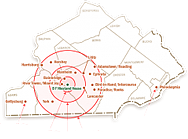722 E. Market St. Marietta, PA 17547Phone: (717)426-8415
Tour the Early American Religious Community of the Ephrata Cloister
Religious freedom is one of America's founding tenets, and the earliest settlers came to this new country to escape persecution for their faith. The Ephrata Cloister is one example of a thriving religious community born out of distrust for organized churches by those who sought a quiet life of contemplation. Dating back to 1732, the Ephrata Cloister is a fascinating display of communal Christianity that survived until the 1930s, and today serves as a museum to the community's views on life, religion, literature and education.
Founded by German immigrant Conrad Beissel, the Ephrata Cloister was a religious community that followed the teachings of the Seventh Day Baptists. It was originally established as a small community of religious devotees to Beissel who sought to live a simple and austere life dedicated to God. The community was known for its strict adherence to the Bible and for its emphasis on the importance of personal piety and spiritual discipline. Members of the community, both men and women, lived in celibacy, prayer and manual labor. They wore distinctive white robes and caps, which were seen as symbols of their devotion to God.
Despite their rigorous way of life, the Ephrata Cloister attracted many followers, and by the mid-18th century, it had grown into a large and thriving community. By the early 1750s, nearly 80 celibate Brothers and Sisters were housed in impressive Germanic log, stone and half-timbered buildings. At the same time, nearly 200 family members known as Householders, occupied nearby homes and farms. The members of the community also were skilled craftsmen and artists, and they produced a wide range of goods, including textiles, pottery and printing.
In addition to its religious activities, the Ephrata Cloister was also an important cultural center in colonial America. The members of the community were known for their musical and artistic talents, and they produced a wide range of literature, music and art. The community's printing press, which was established in 1745, was one of the most important in colonial America, and it produced a wide range of books, pamphlets and musical scores.
Today, the Ephrata Cloister is a National Historic Landmark and a popular tourist destination. Guided tours last about 1 hour and 15 minutes and offer a look at the ideas, lifestyle and achievements of this unique early American community. The site has nine buildings, including the Meetinghouse, the Sisters' House, the chapel and several dormitory buildings, as well as a visitor center and museum store. Self-guided tours are also available.
A visit to the Ephrata Cloister is definitely worth adding to your vacation itinerary during your next stay with us B.F. Hiestand House. There's no better way to learn about this important historical, religious and cultural part of early American history than to see it for yourself.



